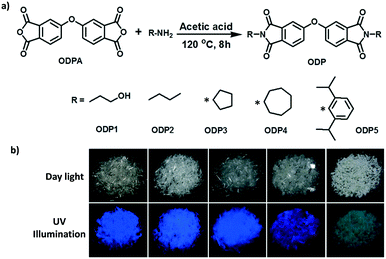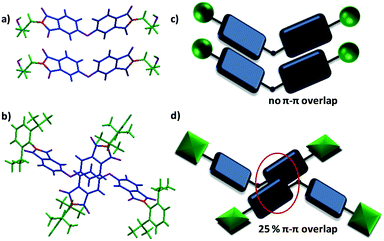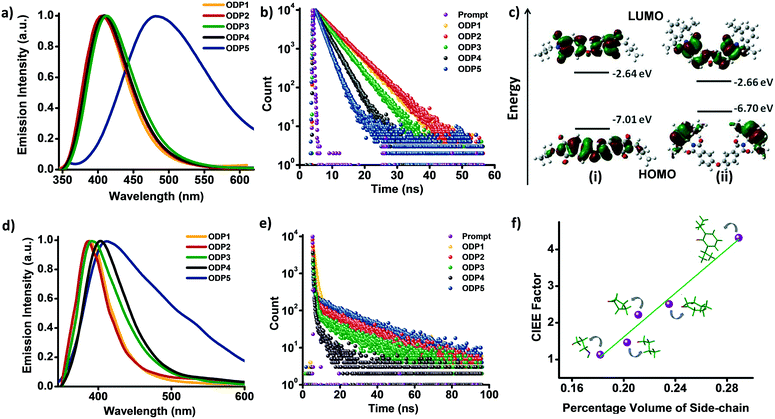V-shaped oxydiphthalimides: side-chain engineering regulates crystallisation-induced emission enhancement†
Gopika
Gopan‡
,
P. S.
Salini‡
,
Somadrita
Deb
and
Mahesh
Hariharan
*
School of Chemistry, Indian Institute of Science Education and Research Thiruvananthapuram, CET Campus, Sreekaryam, Thiruvananthapuram, Kerala, India 695016. E-mail: mahesh@iisertvm.ac.in
First published on 24th October 2016
Abstract
Tuning the luminescence properties of solid state materials by controlling the molecular packing in the crystal has played an important role in designing new functional materials. A series of five V-shaped oxydiphthalimides (ODPs) were synthesised. Side-chain engineering has been successfully utilized to systematically tune their luminescence properties in the crystalline state by introducing sterically bulky side-chains at the imidic nitrogen. Fluorescence spectroscopy and single crystal X-ray analyses disclose the effect of conformational twisting and bulkiness of imidic substituents on crystallisation-induced emission enhancement (CIEE). Detailed analysis revealed that the CIEE factor of ODPs shows a linear dependence on the percentage volume of the side-chain.
Introduction
Organic luminescent materials have gained much attention in recent years owing to their potential applications in the fields of light emitting diodes (OLEDs),1 solid state lasers,2 sensors,3 labels4 and thin film transistors (OTFT).5 The development of efficient solid state emitters from organic fluorophores is a challenging yet desirable task in optoelectronics. In most cases, organic dyes with high fluorescence quantum yields in the solution state do not show any detectable emission in the solid state due to the formation of excimers and exciplexes.6 The last few decades have witnessed the emergence of a new class of functional materials with aggregation-induced emission enhancement (AIE/AIEE) characteristics, wherein the aggregated state of molecules was found to show emission efficiency much higher than that in the solution state.7 The number of molecules that show enhanced emission in the crystalline state remains to be exiguous.8 Due to strong π–π stacking interactions in the crystalline state, non-radiative decay is more probable to occur.8,9 Since crystalline films show alluring charge mobility while constructing light-emitting diodes, researchers are in perpetual quest for luminescent materials that show crystallisation-induced emission enhancement (CIEE).10 Since a close packed arrangement of molecules in the crystalline state inevitably, in most cases, quenches emission, it is highly essential to develop a strategy to enhance the luminescence of a crystalline material by manipulating the interactions at the molecular level.11 The mechanism of CIEE is ascribed to the twisted conformation of the molecules in the crystalline state that prevents strong intermolecular π–π interaction. Restricted intramolecular rotations in the crystalline state can also contribute to CIEE. As a consequence, the photoexcited luminogens decay to the ground state through radiative pathways thus boosting the fluorescence emission.12 Such an understanding about the structure–property correlation can serve as a basis for designing newer and better efficient solid state luminescent materials for practical applications. Constant efforts in this direction have given rise to many useful covalent13 and non-covalent14 synthesis strategies that can be used to develop organic crystalline materials with significant emission efficiency. Introduction of alkyl/aryl side-chains around the luminescent core can effectively perturb the electronic coupling between the chromophores. Albeit many reports on the effect of flexible side-chains on the device performance of OFETs and solar cells,15 the possibilities of tuning solid state luminescence properties using side-chain engineering have received less attention.16Our continued efforts to understand the photophysical properties of crystalline/assembled ryleneimides such as naphthalimide17 and perylenimide18 prompted us to explore the properties of their lower analogue, phthalimide. Herein, we introduce oxydiphthalimides (ODPs) as potential candidates for the aforementioned CIEE family. Although ODPs have been extensively studied for building polyimides and copolyimides,19 their photophysical properties are hitherto unknown in the literature. With continuous endeavours to construct solid state luminescent materials,20 in this work, we reveal the effect of the molecular structure, conformational twisting and solid state packing on the CIEE process of a series of ODPs via side-chain engineering of the imide moiety. We herein report the first example of exercising side-chain engineering on a V-shaped chromophore to obtain a linear dependence of CIEE on the bulkiness of the chosen side-chains.
Experimental section
Materials and methods
4,4′-Oxydiphthalic anhydride (95%), hydroxypropyl amine, n-propyl amine, cyclopentyl amine, cycloheptyl amine and 2,6-diisopropylaniline (97%) were purchased from Sigma Aldrich and used as such without further purification. Thin layer chromatography (TLC) analysis was performed on pre-coated aluminum plates of silica gel 60 F254 plates (0.25 mm, Merck), and the developed TLC plates were visualized under short and long wavelength UV lamps. Flash column chromatography was performed using silica gel of 200−400 mesh employing a solvent polarity correlated with the TLC mobility observed for the substance of interest. Yields refer to chromatographically and spectroscopically homogeneous substances. Melting points (m.p.) were obtained using a capillary melting point apparatus and are reported without correction. Photophysical measurements of the derivatives were carried out in a cuvette of 3 mm path length unless otherwise mentioned. Absorption and emission spectra were recorded on Shimadzu UV-3600 UV-VIS-NIR and Horiba Jobin Yvon Fluorolog spectrometers, respectively. Lifetime measurements were carried out on an IBH picosecond time correlated single photon counting (TCSPC) system. The pulse width of the excitation (λexc = 340 nm) source is determined to be <100 ps. The fluorescence decay profiles were deconvoluted using IBH data station software version 2.1, and fitted with exponential decay, minimizing the χ2 values. 10 μM solutions of ODP1–5 in CHCl3 were used for solution based photophysical measurements unless otherwise mentioned.General procedure for the syntheses of ODP1–5 from 4,4′-oxydiphthalic anhydride (ODPA)
3.15 g (0.01 mol) of 4,4′-oxydiphthalic anhydride (ODPA) and 40 mL of acetic acid were added to a 100 mL two-neck round bottom flask equipped with a condenser and a mechanical stirrer. After ODPA dissolves in acetic acid, 0.022 mol of amine was added dropwise. The mixture was refluxed for 5–8 h at 120 °C, then cooled to room temperature and poured into cold water (Fig. 1a). The precipitate was collected using vacuum filtration and then purified using column chromatography. The respective oxydiphthalimides (ODPs) were obtained as white solids in 60–80% yields. Slow evaporation of ODPs from varying compositions of the chloroform![[thin space (1/6-em)]](https://www.rsc.org/images/entities/char_2009.gif) :
:![[thin space (1/6-em)]](https://www.rsc.org/images/entities/char_2009.gif) hexane mixture yielded colourless solvent-free crystals (Fig. 1b). ODP1–5 were characterized by spectroscopic and analytical techniques and their structures were confirmed by single crystal X-ray diffraction analysis. ODP1–5 crystallized in a monoclinic crystal system with ODP1–4 belonging to the same space group (C2/c) while ODP5 belongs to P21/c (Table 1).
hexane mixture yielded colourless solvent-free crystals (Fig. 1b). ODP1–5 were characterized by spectroscopic and analytical techniques and their structures were confirmed by single crystal X-ray diffraction analysis. ODP1–5 crystallized in a monoclinic crystal system with ODP1–4 belonging to the same space group (C2/c) while ODP5 belongs to P21/c (Table 1).
| ODP1 | ODP2 | ODP3 | ODP4 | ODP5 | |
|---|---|---|---|---|---|
| Empirical formula | C22H20N2O7 | C24H24N2O5 | C26H24N2O5 | C30H32N2O5 | C40H40N2O5 |
| Formula weight (g) | 424.40 | 420.46 | 444.48 | 500.59 | 628.76 |
| Color, shape | Colorless, block | Colorless, block | Colorless, rectangular | Colorless, rectangular | Colorless, block |
| Temperature (K) | 296 | 296 | 296 | 296 | 296 |
| Crystal system | Monoclinic | Monoclinic | Monoclinic | Monoclinic | Monoclinic |
| Space group | C2/c | C2/c | C2/c | C2/c | P21/c |
| a (Å) | 16.685 | 16.477 | 43.489 | 32.385 | 13.856 |
| b (Å) | 5.027 | 5.156 | 5.242 | 5.311 | 20.531 |
| c (Å) | 22.863 | 24.853 | 19.472 | 5.679 | 13.634 |
| α (deg) | 90 | 90 | 90 | 90 | 90 |
| β (deg) | 96 | 92.79 | 104.45 | 110.53 | 116.97 |
| γ (deg) | 90 | 90 | 90 | 90 | 90 |
| Volume (Å3) | 1907.07 | 2109.00 | 4298.70 | 2526.00 | 3456.80 |
| Z | 4 | 4 | 8 | 4 | 4 |
| Density (calculated) | 1.479 | 1.323 | 1.373 | 1.310 | 1.207 |
| No. of reflections collected | 7046 | 8056 | 18![[thin space (1/6-em)]](https://www.rsc.org/images/entities/char_2009.gif) 882 882 |
9708 | 26![[thin space (1/6-em)]](https://www.rsc.org/images/entities/char_2009.gif) 924 924 |
| No. of unique reflections | 1666 | 2160 | 1927 | 9708 | 6085 |
| No. of parameters | 142 | 141 | 298 | 170 | 424 |
| R 1, wR2 [I > 2sigma(I)] | 0.0344, 0.0843 | 0.0612, 0.1761 | 0.0440, 0.1275 | 0.0726, 0.2056 | 0.0554, 0.1462 |
| R 1, wR2 (all data) | 0.0421, 0.0910 | 0.0782, 0.1902 | 0.0620, 0.1608 | 0.0952, 0.2360 | 0.1039, 0.1906 |
| Absorption coefficient | 0.112 | 0.093 | 0.096 | 0.090 | 0.079 |
| F(000) | 888 | 888 | 1872 | 1056 | 1336 |
| Goodness of fit | 1.036 | 1.057 | 1.141 | 1.046 | 1.063 |
| CCDC number | 1490507 | 1490508 | 1490509 | 1490510 | 1490511 |
ODP1 (yield = 75%): m.p. 156–157 °C; 1H NMR (500 MHz, CDCl3): δ = 7.83 (d, J = 8.1 Hz, 2H), 7.36 (s, 2H), 7.32 (d, J = 8.1, 2H), 3.79 (t, J = 6.4 Hz, 4H), 3.57 (q, J = 5.9, 4H), 2.28 (t, J = 6.33, 2H), 1.85–1.79 (m, 4H); 13C NMR (125 MHz, CDCl3): δ = 164.82, 159.25, 131.83, 127.52, 125.98, 119.73, 115.75, 60.25, 38.16, 32.05; IR (KBr): 3510, 3071, 2938, 2884, 1761, 1695, 1612, 1477, 1441, 1395, 1265, 1229, 1123, 1072, 934, 858, 748 cm−1; HR-MS (EI)-(m/z): 424.1327; anal. calcd. for C22H20N2O7: C, 62.26; H, 4.75; N, 6.60; found: C, 62.19; H, 4.54; N, 6.40.
ODP2 (yield = 68%): m.p. 148–149 °C; 1H NMR (500 MHz, CDCl3): δ = 7.8 (d, J = 8.0 Hz, 2H), 7.35 (s, 2H), 7.29 (d, J = 8.0, 2H), 3.61 (t, J = 7.5 Hz, 4H), 1.56–1.61 (m, 4H), 1.28–1.32 (m, 4H), 0.88 (t, J = 7.5 Hz, 6H); 13C NMR (125 MHz, CDCl3): δ = 164.91, 160.17, 132.26, 127.35, 124.92, 119.64, 115.14, 40.97, 31.59, 20.18, 13.97; IR (KBr): 3071, 2965, 2929, 2870, 1778, 1722, 1607, 1470, 1369, 1273, 1231, 1105, 835, 748 cm−1; HR-MS (EI)-(m/z): 420.1738; anal. calcd. for C24H24N2O5: C, 68.56; H, 5.75; N, 6.66; found: C, 69.05; H, 5.63; N, 6.52.
ODP3 (yield = 70%): m.p. 163–164 °C. 1H NMR (500 MHz, CDCl3): δ = 7.86 (d, J = 8.0 Hz, 2H), 7.41 (s, 2H), 7.35 (d, J = 8.0, 2H), 4.60–4.67 (m, 2H), 2.11–2.13 (m, 8H), 1.63–1.67 (m, 8H); 13C NMR (125 MHz, CDCl3): δ = 165.34, 158.56, 131.48, 127.73, 125.19, 119.92, 116.47, 42.82, 28.06, 19.38; IR (KBr): 3071, 2936, 2866, 1767, 1705, 1612, 1477, 1439, 1393, 1356, 1261, 1227, 1173, 1088, 1051, 945, 853, 748 cm−1; HR-MS (EI)-(m/z): 444.1756; anal. calcd. for C26H24N2O5: C, 70.26; H, 5.44; N, 6.30; found: C, 70.81; H, 5.39; N, 6.04.
ODP4 (yield = 77%): m.p. 153–154 °C. 1H NMR (500 MHz, CDCl3): δ = 7.83 (d, J = 8.1 Hz, 2H), 7.38 (s, 2H), 7.33 (d, J = 8.1, 2H), 4.23–4.27 (m, 2H), 1.79–1.82 (m, 8H), 1.51–1.65 (m, 16H); 13C NMR (125 MHz, CDCl3): δ = 164.85, 158.39, 131.02, 126.70, 123.51, 121.84, 117.29, 42.16, 33.47, 30.05, 25.13; IR (KBr): 2953, 2872, 1767, 1703, 1612, 1474, 1373, 1265, 1231, 1088, 748 cm−1; HR-MS (EI)-(m/z): 500.2381; anal. calcd. for C30H32N2O5: C, 71.98; H, 6.44; N, 5.60; found: C, 72.46; H, 6.30; N, 5.34.
ODP5 (yield = 63%): m.p. 210–211 °C. 1H NMR (500 MHz, CDCl3): δ = 7.97 (d, J = 8.0 Hz, 2H), 7.50 (s, 2H), 7.48 (d, J = 8.5 Hz, 4H), 7.41 (t, J = 8.0 Hz, 2H), 7.23 (d, J = 8.0 Hz, 2H), 2.63–2.69 (m, 4H), 1.14 (d, J = 11, 24H); 13C NMR (125 MHz, CDCl3): δ = 162.86, 159.18, 142.94, 134.82, 130.24, 126.09, 123.93, 122.40, 122.02, 121.17, 115.89, 25.14, 23.26; IR (KBr): 2924, 2859, 1767, 1701, 1609, 1470, 1435, 1368, 1261, 1227, 1090, 847, 746 cm−1; HR-MS (EI)-(m/z): 628.2914; anal. calcd. for C40H40N2O5: C, 76.41; H, 6.41; N, 4.46; found: C, 76.56; H, 6.45; N, 4.06.
Results and discussion
A series of five oxydiphthalimides (ODP1–5), which differ in the substituents at imidic nitrogen, were synthesised using condensation reaction of oxydiphthalic anhydride with various amines as per the procedure outlined in Fig. 1a. The amines were chosen in such a way that there is a systematic increase in the bulkiness of the alkyl/aryl group attached to nitrogen. Single crystal X-ray diffraction analysis revealed that ODP1–5 displayed twisted structures, with a V-shape geometry, in which the phthalimide rings are nearly orthogonal to each other with angle between their planes being 77.40° (ODP1), 74.48° (ODP2), 76.69° (ODP3), 70.08° (ODP4) and 74.95° (ODP5) (Fig. 2). Furthermore, in the case of ODPs with bulky side-chains (ODP3–5), the dihedral angle between the phthalimide ring and the bulky substituents is 87.52° (ODP3), 85.77° (ODP4) and 87.15° (ODP5), respectively, suggesting a near orthogonal arrangement (Fig. S1, ESI†). In ODP1–4, steric inhibition arising from such a geometrical arrangement tends to maintain a certain distance between the phthalimide units of adjacent molecules (Fig. 3a). Such an arrangement suppresses the close packing and π–π intermolecular interactions, thereby inhibiting the face to face interaction in ODP1–4. Top and side views (Fig. 4 and 5) of the neighbouring molecular pair in crystalline ODP1–4 show that the phthalimide rings of neighbouring molecules do not stack on top of each other. Introduction of the bulky 2,6-diisopropylphenyl moiety on the imidic nitrogen brought about considerable changes in crystalline ODP5. The ODP5 molecule adopts an entirely different packing arrangement in the crystal with each pair of neighbouring molecules forming a dimer (Fig. 3b), facilitated by the π–π interaction between phthalimide units. The arrangement of the nearest neighbours in ODP1, as a representative example of ODP1–4, and ODP5 is depicted in Fig. 3c and d. The figure clearly shows the π–π interaction aided by the bulky side-chain in ODP5 which results in a 25% π–π overlap. In crystalline ODP1–5, C⋯O, O⋯H and O⋯O interactions act as the principal driving forces for the molecular packing (Fig. S2–S6, ESI†). The combined effects of such weak interactions fix the molecular conformation of ODP1–5 in the crystalline state.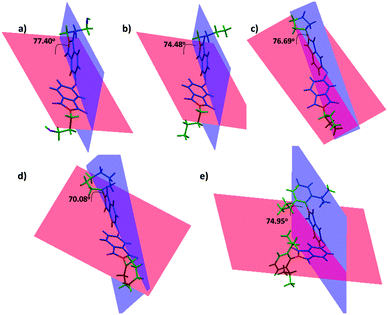 | ||
| Fig. 2 Angles between the planes of phthalimide units in the crystal packing of a) ODP1, b) ODP2, c) ODP3, d) ODP4 and e) ODP5. | ||
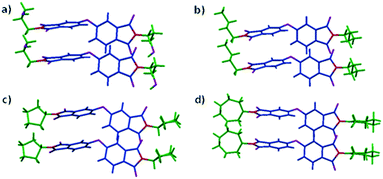 | ||
| Fig. 4 Top view of a) ODP1, b) ODP2, c) ODP3 and d) ODP4 exhibiting a negligible aerial overlap between the phthalimide units in close packing. | ||
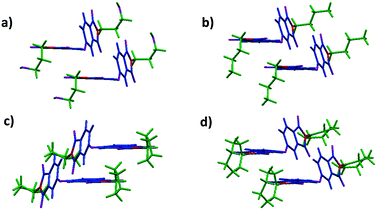 | ||
| Fig. 5 Side view of a) ODP1, b) ODP2, c) ODP3 and d) ODP4 exhibiting a negligible aerial overlap between the phthalimide units in close packing. | ||
The steady state absorption spectra of ODP1–5 in chloroform exhibited a band centered at 233 nm (Table 2; Fig. S7, ESI†), with a tail extending up to 350 nm. Analysis of the absorption spectrum shows that the peak positions are independent of the imidic substituents. The absorption spectra are governed by the n to π* and π to π* transitions of the phthalimide core.21 Upon excitation at 340 nm, ODP1–4 in chloroform exhibited a broad emission centered at 407 nm (Table 2; Fig. 6a; Fig. S8 and S9, ESI†) with quantum yields (Φf) of 23.6%, 5.7%, 4.4% and 3.4%, respectively (Table 2). ODP5 showed a notable difference in the emission spectra where a significant red-shifted band at 481 nm (Table 2; Fig. 6a; Fig. S9, ESI†) was observed with a quantum yield of 0.5%. Picosecond time-resolved fluorescence measurements of ODP1–5 in chloroform exhibit a monoexponential decay with short fluorescence lifetimes (τ = 1.89–10.53 ns) (Fig. 6b; Table 2) when monitored at respective emission maxima upon excitation at 340 nm. The red shift in the emission spectra as well as the observed lower fluorescence quantum yield of ODP5 is indicative of twisted intramolecular charge transfer (TICT)10b in solution. Solvent dependent studies of ODP5 (Fig. S10a, ESI†) show a red shift in the emission maximum (457 nm to 491 nm) with the increase in polarity of the solvent from cyclohexane to acetonitrile. With further increase in the solvent polarity, the emission got quenched. Similar studies were carried out in the case of ODP2 for comparison, but a solvent dependent shift in the emission maximum was not observed (Fig. S10b, ESI†). The difference between the excited- and ground-state dipole moments in ODP5 is estimated to be 5.65 D employing the Lippert–Mataga equation (Fig. S10c, ESI†). Frontier molecular orbital (FMO) analysis (Fig. 6c; Table S1, ESI†) shows that the electron density of the HOMO and LUMO is distributed throughout the whole molecule in ODP1–4. However, in the case of ODP5, the electron density is completely concentrated on the 2,6-diisopropylphenyl moiety in the HOMO, whereas in the LUMO, complete localization of the electron density is on the phthalimide moiety. The FMOs calculated for the representative dimer pair in ODP5 exhibit a similar feature to that of monomeric ODP5 (Table S1, ESI†). The FMO analysis, in addition to the solvent polarity dependence of emission maxima, is clearly indicative of the TICT between the phthalimide unit and the imide moiety in the ground state of ODP5.
| λ abs (nm) | λ f (nm) | Φ f | τ f (ns) | k r (×106) | k nr (×106) | λ abs (nm) | λ f (nm) | Φ f | τ f (ns) [amplitude] (%) | k r (×103) | k nr (×103) | Φ f /Φfa | |
|---|---|---|---|---|---|---|---|---|---|---|---|---|---|
| a Chloroform solution. b Crystalline state; abs – absorption; f – fluorescence; the observed decrease in the rate of the radiative decay for crystalline ODP5 when compared to that for ODP5 in solution is indicative of the formation of the ‘H’ type aggregate. | |||||||||||||
| ODP1 | 234 | 407 | 0.236 | 10.17 | 0.048 | 0.157 | 361 | 388 | 0.267 | 10.06 [84], 179.86 [16] | 1.880 | 5.190 | 1.132 |
| ODP2 | 234 | 406 | 0.057 | 10.53 | 0.014 | 0.231 | 348 | 386 | 0.084 | 171.98 [29], 3.36 [71] | 0.520 | 5.690 | 1.466 |
| ODP3 | 234 | 409 | 0.044 | 8.23 | 0.009 | 0.203 | 347 | 391 | 0.097 | 6.65 [81], 108.21 [19] | 1.113 | 10.370 | 2.220 |
| ODP4 | 233 | 412 | 0.034 | 5.84 | 0.008 | 0.230 | 343 | 403 | 0.085 | 2.86 [62], 16.196 [38] | 6.430 | 69.270 | 2.511 |
| ODP5 | 232 | 482 | 0.005 | 1.89 | 0.002 | 0.350 | 341 | 411 | 0.020 | 5.65 [22], 173.72 [78] | 0.116 | 5.690 | 4.320 |
In the crystalline state, the diffuse reflectance absorption spectra of ODP1–5 showed a band around 340–360 nm which is red shifted compared to that in the solution state (Table 2; Fig. S7, ESI†). Upon excitation at 340 nm, ODP1–2 showed a band at 387 nm, whereas ODP3–5 showed bands at 391 nm, 403 nm and 411 nm, respectively (Fig. 6d; Table 2). As the bulkiness of the substituents at imidic nitrogen increases, a progressive red shift in the emission maximum of the crystalline ODP was observed. The fluorescence lifetime decay profiles of crystalline ODP1–5 follow a bi-exponential fit with a longer lifetime in addition to the lifetime corresponding to the monomer species (Fig. 6e; Table 2) when excited at 340 nm and monitored at the respective emission maxima. Lifetime analysis of crystalline ODP1–4 revealed that the major emissive component belongs to the monomeric species with the shorter lifetime. Steady state emission of crystalline ODP5 arises predominantly from the aggregated species having a longer lifetime. By virtue of the twisted conformation, ODP1–4 are devoid of H/J-aggregates. As a result, the crystalline state of ODP1–4 manifests a monomer-like emission. In contrast to ODP1–4, two phthalimide moieties in ODP5 from adjacent molecules form a dimer and adopt a face-to-face π-stacked arrangement with an interplanar separation (dπ–π) of 3.73 Å. The blue shift in the emission maxima in combination with the lower kr value of crystalline ODP5 compared to that in the solution state indicates the possibility of H-like aggregates (Table 2). In ODP1–5, inhibition of the internal rotations due to the weak interactions in the crystal reduces non-radiative relaxation, thereby resulting in enhanced crystalline emission. The CIEE factor, which is the relative quantum yield values of the crystalline state with respect to the solution state (φf(crystal)/φf(solution)) of ODP1–5 (Table 2) was found to be 1.132, 1.466, 2.220, 2.511 and 4.320 for ODP1–5, respectively. The plot of the CIEE factor vs. percentage volume22 of the side-chains (Fig. 6f) reflects a linear relationship between the enhancement in emission and the bulkiness of the side-chains on the imidic nitrogen. In contrast, we observed an increase in the aggregation-induced enhanced emission (AIEE) of ODPs with the decrease in the percentage volume of the side-chains (Fig. S11, ESI†).
Hirshfeld surface analysis provides additional insight into the molecular interactions of ODP1–5 (Table S2†). The strong C⋯H contacts including the C–H⋯π interactions comprise 18.1%, 17.0%, 16.6%, 13.6% and 17.5% of the total Hirshfeld surfaces for ODP1, ODP2, ODP3, ODP4 and ODP5, respectively, whereas the C⋯C interactions contribute 0.3%, 0.1%, 2.3%, 2.5% and 1.9%, respectively. In ODP1–5, the contribution of the contacts including the π–π interactions is negligible compared to the other interactions present in the crystal (Fig. S12, ESI†).
Conclusions
In summary, five V-shaped N-substituted oxydiphthalimides with varying imide side-chains are reported. Topological analyses revealed that the introduction of sterically bulky substituents around the luminescent core has increased the extent of close packing in the crystals. The relatively high quantum yield of crystalline ODP1–5 shows that ODPs are promising candidates for the CIEE family. Solvent dependent emission studies and FMO analysis are indicative of TICT in ODP5. Side-chain engineering was successfully utilised to obtain a linear relation between the volume of the side-chain and the order of emission enhancement from the solution state to the crystalline state. The strategy of regulating the luminescence properties of crystalline solids by varying the bulkiness of the side-chains at the molecular level could be exploited in the design and construction of organic luminescent materials. We believe that the facile synthesis and easy crystallising nature of ODP derivatives with CIEE characteristics will provide them a secured position as a new versatile class of luminogens.Acknowledgements
M. H. acknowledges Kerala State Council for Science, Technology and Environment (KSCSTE) for the support of this work, 007/KSYSA-RG/2014/KSCSTE. The authors thank Alex P. Andrews, IISER-TVM for single crystal X-ray structure analyses. Gopika Gopan thanks INSPIRE Fellowship for the financial assistance.Notes and references
-
(a) M. A. Baldo, D. F. O'Brien, Y. You, A. Shoustikov, S. Sibley, M. E. Thompson and S. R. Forrest, Nature, 1998, 395, 151 CrossRef CAS
; (b) Y. Gong, J. Liu, Y. Zhang, G. He, Y. Lu, W. B. Fan, W. Z. Yuan, J. Z. Sun and Y. Zhang, J. Mater. Chem. C, 2014, 2, 7552 RSC
.
-
(a) X. Wang, Q. Liao, H. Li, S. Bai, Y. Wu, X. Lu, H. Hu, Q. Shi and H. Fu, J. Am. Chem. Soc., 2015, 137, 9289 CrossRef CAS PubMed
; (b) M. Wei, R. Huang, K. Guo, Y. Jing, T. Xu and B. Wei, J. Mater. Chem. C, 2014, 2, 8131 RSC
; (c) Z. Yu, Y. Wu, Q. Liao, H. Zhang, S. Bai, H. Li, Z. Xu, C. Sun, X. Wang, J. Yao and H. Fu, J. Am. Chem. Soc., 2015, 137, 15105 CrossRef CAS PubMed
.
-
(a) M. Wang, D. Zhang, G. Zhang and D. Zhu, Chem. Commun., 2008, 4469 RSC
; (b) J. Wu, W. Liu, J. Ge, H. Zhang and P. Wang, Chem. Soc. Rev., 2011, 40, 3483 RSC
; (c) P. Mazumdar, D. Das, G. P. Sahoo, G. Salgado-Moran and A. Misra, Phys. Chem. Chem. Phys., 2015, 17, 3343 RSC
; (d) P. Mazumdar, D. Das, G. P. Sahoo, G. Salgado-Moran and A. Misra, Phys. Chem. Chem. Phys., 2014, 16, 6283 RSC
.
- M. Bruchez, M. Moronne, P. Gin, S. Weiss and A. P. Alivisatos, Science, 1998, 281, 2013 CrossRef CAS PubMed
.
-
(a) M. M. Durban, P. D. Kazarinoff, Y. Segawa and C. K. Luscombe, Macromolecules, 2011, 44, 4721 CrossRef CAS
; (b) X. Guo, R. P. Ortiz, Y. Zheng, M.-G. Kim, S. Zhang, Y. Hu, G. Lu, A. Facchetti and T. J. Marks, J. Am. Chem. Soc., 2011, 133, 13685 CrossRef CAS PubMed
; (c) Y. Zhou, W.-J. Liu, Y. Ma, H. Wang, L. Qi, Y. Cao, J. Wang and J. Pei, J. Am. Chem. Soc., 2007, 129, 12386 CrossRef CAS PubMed
.
- Z. Xie, B. Yang, F. Li, G. Cheng, L. Liu, G. Yang, H. Xu, L. Ye, M. Hanif, S. Liu, D. Ma and Y. Ma, J. Am. Chem. Soc., 2005, 127, 14152 CrossRef CAS PubMed
.
-
(a) J. Luo, Z. Xie, J. W. Y. Lam, L. Cheng, H. Chen, C. Qiu, H. S. Kwok, X. Zhan, Y. Liu, D. Zhu and B. Z. Tang, Chem. Commun., 2001, 1740 RSC
; (b) B.-K. An, S.-K. Kwon, S.-D. Jung and S. Y. Park, J. Am. Chem. Soc., 2002, 124, 14410 CrossRef CAS PubMed
.
- J. Tong, Y. J. Wang, Z. Wang, J. Z. Sun and B. Z. Tang, J. Phys. Chem. C, 2015, 119, 21875 CAS
.
-
(a) Z. Chen, J. Zhang, M. Song, J. Yin, G.-A. Yu and S. H. Liu, Chem. Commun., 2015, 51, 326 RSC
; (b) Y. Lin, G. Chen, L. Zhao, W. Z. Yuan, Y. Zhang and B. Z. Tang, J. Mater. Chem. C, 2015, 3, 112 RSC
; (c) C. Yang, Q. T. Trinh, X. Wang, Y. Tang, K. Wang, S. Huang, X. Chen, S. H. Mushrif and M. Wang, Chem. Commun., 2015, 51, 3375 RSC
.
-
(a) Y. Dong, J. W. Y. Lam, A. Qin, Z. Li, J. Sun, H. H. Y. Sung, I. D. Williams and B. Z. Tang, Chem. Commun., 2007, 40 RSC
; (b) T. Han, X. Feng, D. Chen and Y. Dong, J. Mater. Chem. C, 2015, 3, 7446 RSC
.
- Y.-X. Li, X.-F. Yang, J.-L. Miao, Z.-W. Zhang and G.-X. Sun, CrystEngComm, 2016, 18, 2098 RSC
.
-
B. Z. Tang and A. Qin, Aggregation-Induced Emission: Fundamentals, Wiley, 2013 Search PubMed
.
- S. Mukherjee and P. Thilagar, Proc. Natl. Acad. Sci., India, Sect. A, 2014, 84, 131 CrossRef
.
-
(a) D. Yan, H. Yang, Q. Meng, H. Lin and M. Wei, Adv. Funct. Mater., 2014, 24, 587 CrossRef CAS
; (b) G. Fan, X. Yang, R. Liang, J. Zhao, S. Li and D. Yan, CrystEngComm, 2016, 18, 240 RSC
; (c) S. Li, Y. Lin and D. Yan, J. Mater. Chem. C, 2016, 4, 2527 RSC
.
-
(a) F. Zhang, Y. Hu, T. Schuettfort, C.-a. Di, X. Gao, C. R. McNeill, L. Thomsen, S. C. B. Mannsfeld, W. Yuan, H. Sirringhaus and D. Zhu, J. Am. Chem. Soc., 2013, 135, 2338 CrossRef CAS PubMed
; (b) X.-Y. Wang, F.-D. Zhuang, X. Zhou, D.-C. Yang, J.-Y. Wang and J. Pei, J. Mater. Chem. C, 2014, 2, 8152 RSC
; (c) J. Y. Back, T. K. An, Y. R. Cheon, H. Cha, J. Jang, Y. Kim, Y. Baek, D. S. Chung, S.-K. Kwon, C. E. Park and Y.-H. Kim, ACS Appl. Mater. Interfaces, 2015, 7, 351 CrossRef CAS PubMed
.
-
(a) S. Sekiguchi, K. Kondo, Y. Sei, M. Akita and M. Yoshizawa, Angew. Chem., Int. Ed., 2016, 55, 6906 CrossRef CAS PubMed
; (b) J. Mei and Z. Bao, Chem. Mater., 2014, 26, 604 CrossRef CAS
.
- A. R. Mallia, P. S. Salini and M. Hariharan, J. Am. Chem. Soc., 2015, 137, 15604 CrossRef CAS PubMed
.
-
(a) R. T. Cheriya, A. R. Mallia and M. Hariharan, Energy Environ. Sci., 2014, 7, 1661 RSC
; (b) R. T. Cheriya, K. Nagarajan and M. Hariharan, J. Phys. Chem. C, 2013, 117, 3240 CrossRef CAS
.
- P. Thiruvasagam and B. Saritha, J. Polym. Res., 2015, 22, 1 CrossRef CAS
.
-
(a) S. K. Rajagopal, A. M. Philip, K. Nagarajan and M. Hariharan, Chem.
Commun., 2014, 50, 8644 CAS
; (b) S. K. Rajagopal, V. S. Reddy and M. Hariharan, CrystEngComm, 2016, 18, 5089 RSC
; (c) A. R. Mallia, R. Sethy, V. Bhat and M. Hariharan, J. Mater. Chem. C, 2016, 4, 2931 RSC
.
- V. Wintgens, P. Valat, J. Kossanyi, L. Biczok, A. Demeter and T. Berces, J. Chem. Soc., Faraday Trans., 1994, 90, 411 RSC
.
- The bulkiness of the side-chains attached to the phthalimide core in ODP1–5 is associated directly with the relative volume of the side-chains with respect to the whole molecule (percentage volume) in each case. The volume of the required fragments was determined quantitatively using Crystal Explorer 2.1.
Footnotes |
| † Electronic supplementary information (ESI) available: 1H NMR and 13C NMR of ODP1–5. CCDC 1490507–1490511. For ESI and crystallographic data in CIF or other electronic format see DOI: 10.1039/c6ce01738j |
| ‡ These authors contributed equally. |
| This journal is © The Royal Society of Chemistry 2017 |

